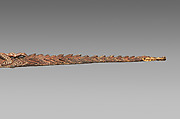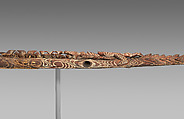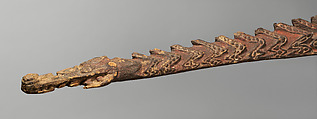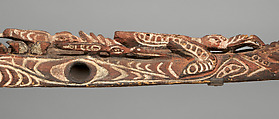Crocodile Figure (Taki)
Not on view
The most sacred objects of the Karawari people, who live along the middle Korewori River, were massive crocodile figures, which were referred to as taki, the same term used for living crocodiles, although each also bore the specific name of a totemic being or clan ancestor. Crocodile effigies were used formerly in war magic. In Ambonwari village, where this work originated, the crocodile’s spirit was said to “appear in dreams to stir up thoughts of war . . . and let the important men know which village to attack and how many inhabitants to kill.” In preparing for a raid, men often lifted the crocodile with poles, which were inserted into the holes in the sides, and carried it a short distance toward the enemy village. Placed back on the ground, the taki was said to emit a series of taps, indicating the number of enemy heads that would be taken. If successful, the men later placed the heads in the crocodile’s jaws. In some areas, taki were used in male initiation. Bamboo flutes, inserted into the sides, were played; their resonating sound represented the “roar” of the crocodile as it symbolically devoured the initiates. Hearing the sound, the women, gathered outside the ceremonial house, ritually wept for their sons within.
#1743. Crocodile Figure (Taki)
Due to rights restrictions, this image cannot be enlarged, viewed at full screen, or downloaded.
This artwork is meant to be viewed from right to left. Scroll left to view more.










